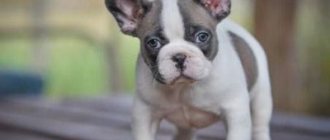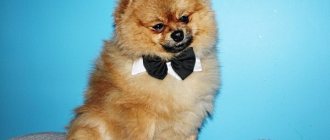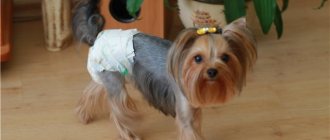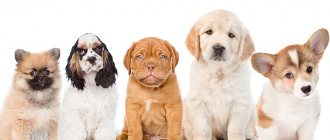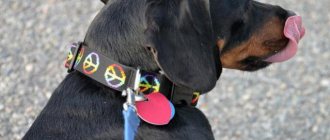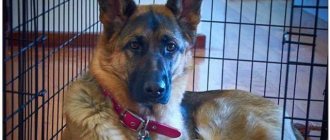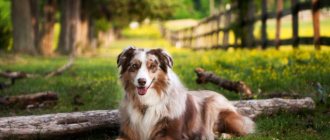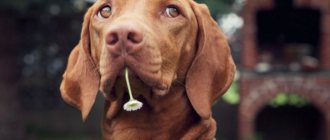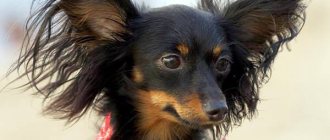a brief description of
- Other names: Russian harlequin hound, Russian piebald hound, Gontchaja russkaja pegaja, Anglo-Russian hound, piebald hound, piebald hound.
- Height: up to 68 cm at the withers.
- Weight: up to 30 kg.
- Color: crimson, saddleback, gray and tan, large spills of white spots and specks are unacceptable, but small white markings are allowed.
- Coat: short on the limbs, relatively long on the body, lying close to the body, the undercoat is thick, meek and dense.
- Life expectancy: up to 12 years.
- Advantages of the breed: dogs are considered unsurpassed assistants in hunting wild animals. The dogs are fearless, and in a pack they kill bears and wild boars. They are distinguished by their constant readiness to serve their owner.
- Difficulties: the dog is reluctant to succumb to the general classical training course, but, nevertheless, easily and quickly masters the skill of a hunter. Almost does not get along with other pets. Not recommended for inexperienced owners as a first dog.
- Price: $200.
Breed standard
Quadrupeds differ in external characteristics. They have short hair, no more than 5 cm in length, with the smallest hairs on their muzzle, paws and ears. A thin tail of medium length with a thick coat looks large. Adult dogs reach from 50 to 70 cm at the withers. Piebald color with dark spots of various shapes. White paws, shoulders, belly. Gray and red inclusions are rare and are considered a defect.
Peculiarities:
- Weight – up to 30 kg.
- Gray, purple, white spots are a breed defect.
- Life expectancy is 12 years.
- They are distinguished by fearlessness. A wild boar or bear may be thrown into groups.
- Always ready to serve their master.
- They are easy to train, master hunting skills, and discover new talents with age.
- They do not get along well with other animals.
The cost of an individual is $200.
How to choose the right Russian hound puppy Pedigree means a lot in this matter, each breeding line is tracked. The character traits and achievements of parents influence future offspring, their adequacy, obedience, and other traits. Signs of purebred:
- Dewclaws on the hind legs.
- White spots.
- Marbled or too dark color.
It is recommended to buy puppies from 5-8 months; at this age, character traits are fully formed, teeth change, and you can better determine the puppy’s readiness to hunt. Each individual must have vaccination certificates. It is not recommended to buy young animals if the ancestors rushed at livestock or did not speak well; the breeders need to ask about this; if they avoid answering, it is better to find another seller.
Puppies are selected for the following qualities:
- Body proportionality.
- Eye color.
- The nose is all black without light spots.
Preference is not always given to the largest representative of the family; they are chosen for their activity, cheerfulness, ability to voice, and the behavior of the parents is always taken into account.
You can buy very small puppies, it is recommended to watch them a little, choose those who have a better developed sense, who are the first to find their mother’s nipples and who whine more often. If the animal is several months old, the breeder will advise on the rules of keeping, feeding, and tell you how to train it to the toilet in diapers. Bitches over 8 years old do not produce healthy offspring, you need to remember this.
Origin story
The Russian Hound breed began to exist at the very end of the 19th century. In 1895, representatives of the breed appeared, whose phenotype underlies modern dogs. Purposeful breeding of the breed began only with the advent of Soviet power, and at the same time the first standard of the Russian hound, dating back to 1925, was approved.
Data on dogs has been changed twice. Amendments were made in 1935, and the breed standard, finally supplemented and divided into types, was approved at the end of 1951.
Purpose of the breed
There are two main types of Russian hounds based on the way they work:
- Dogs for canine hunting of red predators - foxes, wolves. It is believed that Russian hounds perform this work better than greyhounds, since the dogs accompany the object with continuous barking, showing the hunter the direction of movement and the location of the animal.
- Dogs for gun hunting. Unlike canine hunting, gun hunting involves the help of only one dog, tracking, picking up and baiting the hunter with prey.
Dogs in both the first and second cases work perfectly and are still used for their intended purpose.
Character
In the off-season, this classic hunter prefers a relaxing holiday with his family. The dog is relatively loyal to all the inhabitants living under the same roof with him , but excesses are not excluded. The Russian Hound even expresses tolerance towards cats if they were raised next to her from puppyhood. Neighboring animals may be driven out of the dog’s territory in disgrace.
Representatives of the breed are not suitable for apartment living. Animals need space and constant movement. Without fulfilling their direct responsibilities, dogs may develop a feeling of inferiority or uselessness. Therefore, during walks, you need to let your pet run around as much as possible, simulating hunting games.
Choosing a puppy
In acquiring a working category of Russian hound, the key point is the presence of a pedigree, where each breeding line is carefully verified. The quality characteristics of the purchased dog, its adequacy, character and ability to fulfill its purpose depend on this.
Signs of purebred:
- dewclaws on the hind legs;
- a large number of large white spots or frequent specks;
- bright red-tan, marbling in tan, piebald or solid very dark color.
Hunters prefer to take older puppies at the age of 5-8 months , when the main characteristics - character and type of behavior - are fully manifested. Replaced teeth complete the picture of the puppy’s suitability for work. When purchasing a dog, you should make sure that the teenager has received all the vaccinations that a puppy should have at this age.
When buying a puppy, you need to find out about the presence of ancestors who throw at livestock, or dogs that do not give a voice, unless, of course, the breeder answers the questions posed frankly.
Russian hound puppies are purchased either very small, one and a half to two months, or already grown up. When choosing, you should carefully observe the babies and choose the one whose instinct is very developed - he is the first to find the mother's nipples, and squeals more often than others.
When picking up a one-month-old puppy, you should get a full consultation from the breeder about raising and feeding the baby, as well as how to quickly teach the puppy to go to the toilet in a diaper until he gets stronger.
It is not recommended a priori to purchase puppies from an eight-year-old female and older, since at this age Russian hounds produce rickety offspring.
Hound: issues of education and training
photo: Semina Mikhail
Oleg Trushin writes: “How long should a hound race – 50 or 60 minutes? Excuse me, but is this interesting to a simple hunter? I dare say no.” Maybe a simple hunter doesn’t care about this issue. Hunters who hunt with a hound are concerned about this issue. Racers are worried that viscosity may be lost as a result.
When choosing a puppy, Oleg Trushin advises taking a puppy in the village, arguing that prices are lower, hunters know each other well and will advise who is good and who is bad.
I doubt that it will be possible to find a hound with a pedigree in the village, but if there is one, then most likely it was brought from the city. In the regional center you can find hounds with a pedigree, but usually the breeding work here leaves much to be desired. There are practically no outdoor matings, they don’t go to tests and competitions, so you may not find out anything about the exterior, let alone the working qualities of the ancestors.
And sometimes local dog handlers (in rural areas) issue certificates of origin of the puppy without examining the litter. I had such a case when my father and I traveled 150 km for a puppy RPG and in vain (in the litter there were some puppies of a suspicious color and with curly hair, but with Russian pinto hound documents).
Oleg Trushin: “... It will be very good if you establish friendly contact with the owner himself. Go hunting with him and see how his hound works.” Of course, only this way and not otherwise. Better to see once than hear a hundred times. But if you are really a beginner, you have nothing to compare with. Therefore, the best place to start your search for a puppy is with hound competitions and trials, where you can see, hear and compare them in action.
Oleg Trushin: “And always remember the “golden” rule when choosing a puppy: the hunting qualities of a hound depend solely on natural inclinations; if they are not there, then no training, no “elite” education and maintenance will set your hound on the right path.” I believe that by natural inclinations Oleg Trushin meant the blood of his ancestors, who were working dogs. Before this, Oleg Trushin described a case when his son-in-law sent a hound of good blood to his father-in-law, but as a result of bad racing and blood they did not help. But maybe this survivor did not have natural inclinations?
But how do you know if a hound really has no hunting qualities or if its owner was unable to reveal them? I train dogs (OKD, ZKS) and from my experience I can say that education and training are of great importance. Blood plays not the first role.
We often hear from some racers that blood is everything. There is a kind of underestimating attitude towards catching up. Of course, the relationship between training (development of working qualities in the forest + education at home) and blood (pedigree of the dog) is indisputable. I believe that training plays a primary role, since it is not the papers that make a dog, but the training and upbringing of a certain person.
An example from life. My father and I bought a Russian hound puppy; the parents had nothing outstanding in terms of working qualities, judging by the pedigree (they bought the puppy in a rural area). We raised and dragged our survivor into the forest as often as possible, and in the end they were satisfied with his work. I met an acquaintance and he asked: “Well, how’s the survivor?” Me: “Everything is fine, happy.” An acquaintance: “And the father of your survivor practically does not work, and he has no viscosity.”
So is it possible to say 100% that the hunting qualities of a hound, such as viscosity and flair, depend solely on natural inclinations?
| photo: Semina Mikhail |
They say about flair: flair is a component of smell and mind. It turns out that in order for her to have a good instinct, she must be able to use it. And who should teach it, develop the dog’s use of this hunting quality? They say: this hound lacks flair. What exactly – the mind or the sense of smell?
Viscosity – we know that this quality is very important for a hound, without it you won’t get much out of a hound. But what is viscosity? Viscosity is the greed to pursue the animal and search for its traces on the cliff. Almost everyone claims that this quality is innate and is inherited. Yes, this is true, this is a breed trait of hounds. But where do hounds that lack viscosity come from? How many people have thought that as a result of incorrect training (due to the ignorance and inexperience of the owner), a hound of any blood can be spoiled? Don't let this quality develop.
I believe that toughness is a quality that needs to be developed in young hounds during training. If the hound is physically healthy and has received the correct training, it will also have viscosity. What do I mean by correct training? This is beagle training where the owner notices the young dog's mistakes and his own. The most important thing is to correct these mistakes in a timely manner. Convey to the dog what you want from it.
Example. I asked one of my acquaintances to go hunting with me. I think I'll see how it works and listen to the voice. This was a survivor of the Russian hound of 6 autumns. We arrived in the forest. The survivor was attacked. The hound picked up the hare and led it to a small forest island. Less than 10 minutes of rutting time have passed, the survivor breaks down. Another 10 minutes passed, he returned to the owner. The owner, without hesitation, went in the other direction to look for the next hare. I ask: “Do you always hunt like this?” “Yes,” he replies. “When there is no rut, I recall the survivor, and we go look for another hare.”
Is it possible to say about this survivor that it lacks viscosity? Isn't it the owner's fault that the hound returns to the owner after 10 minutes of searching on the rock? I think, having seen such a survivor on a hunt, many would say that the hound lacks viscosity, and would not begin to understand the reason why the hound works this way. After all, everyone is sure that viscosity is inherited.
So for myself I came up with a “golden” rule: pedigree is pedigree, but it is not what makes the dog, but the owner. I believe that training plays a paramount role. In order for a hound to show its working qualities, you need to try to understand the dog’s behavior in a given situation. Make every effort and knowledge to reveal and develop the working qualities of your pet. And before you blame the dog and its ancestors for not having natural inclinations, ask yourself: are you doing everything right?
Sergey ULANOV August 5, 2013 at 00:00
Nicknames and names
A worthy dog should have an appropriate name that reflects the character and inner world of the pet. The Russian hound has a specific appearance and an active lifestyle, constantly on the move. A fairly thin dog with long legs, a sharp, elongated muzzle and special natural characteristics cannot have a boring, simple nickname.
Russian hounds are given short, succinct and sonorous names:
- for males - Brig, Dak, Kent, Last, Mat, Ost, Pete, Ram;
- bitches - Ira, Dory, Liz, Pat, Lynx, Tiki, Una.
Care and maintenance
Caring for the Russian hound , but very specific:
- Cleanliness of the place of detention, including the feeding point with constant disinfection.
- Daily examination of eyes, teeth, ears.
- Brush the coat weekly, and daily during shedding.
Healthy dogs have clean scleras and their eyes never water. If there are accumulations of secretions, you should contact your veterinarian. Ears are cleaned almost daily, since hounds suffer from ear diseases due to their professional activities.
Dogs are washed infrequently; bathing with shampoo is allowed once a month maximum. But after water treatments, swimming in a pond or at home, the ears should be thoroughly dried. The dental system is strong, but nevertheless requires a preventive examination by a veterinarian.
Paws require special care. Even after a walk, you should inspect the pads for splinters, cuts or cracks. The fur between the toes must be trimmed to prevent dirt or snow from getting between the paw pads, especially during the off-season.
Care and education
Recommendations:
- The place of detention is always clean and regularly disinfected.
- Eyes and ears are examined every day.
- The fur is combed out during shedding.
- In healthy pets, the eyes do not water, and dirt does not accumulate in the sclera. If dried discharge accumulates in the corners, contact a veterinarian.
- Daily ear cleaning is necessary to prevent disease.
- Bathing is carried out once a month with shampoo or other detergent. The ears are then dried well.
- Prevention and teeth cleaning at the veterinarian is performed once a month.
- The paws are carefully looked after, the pads are examined after each trip outside, splinters are removed, and cuts are treated.
- Hairs are lined up between the fingers to prevent dirt from accumulating.
Diseases of hounds are transmitted by genes or acquired. Hereditary pathologies:
- Degenerative myelopathy is not treatable and manifests itself as a disorder of the spinal cord.
- Hip dysplasia complicates your pet's life for up to 10 months.
Acquired diseases:
- Conjunctivitis.
- Malignant hyperthermia.
- Using a thermometer, measure the pet's body temperature.
During the season, before going hunting, they are treated with flea and tick repellents. Every six months the digestive system is cleansed of worms.
A balanced diet helps build a healthy body. For the first few months you need to give them what they ate at the nursery. The menu is allowed to change gradually after a few months. Prepared industrial feed TM Pro Plan and clean water are suitable for animals.
A natural product should contain a lot of protein. Livestock breeders recommend raw meat, vitamins.
These are hardy dogs with good instincts, ingenuity, and a loud voice. Not everyone is recommended to have such pets; first you need to familiarize yourself with the rules for raising hunting breeds.
Sometimes stubbornness and disobedience appear. They need rigor and the right approach to training. Without experience in keeping such pets, it is better to get another dog. Education begins at the age of 3 months, the pet already knows how to concentrate and absorbs information well. It is better to instill good habits from an early age. The commands “you can’t”, “you can”, “sit”, your name is learned first. Further training continues after mastering “to me.” Successful completion is rewarded with delicious food or kind words. Disobedience should not go unnoticed by the owner. They cannot be physically punished. This method does not give the desired results, anger towards people appears. If you arouse the animal's interest, there will be many benefits from training. The dog's instincts must be developed; you can start eating after the sound of the hunting horn.
The pet is taught to behave when walking without a leash in the forest, or in other areas. Children cannot be trusted to walk if the four-legged animal is too young. The calm state changes in a second, the pursuit of some animals begins.
Good upbringing and qualities allow you to engage in hunting after a year, and it is better to train from 10 months. The skeleton and muscles are completely strengthened by this time. Work in the field is carried out if all qualities satisfy the owner. Hunting breeds do not need much training to develop their instincts. Sometimes it is enough to put them on the trail of the beast. The dog holds the first prey for several minutes to understand that the game has been caught. The animal is always given to the hunter.
Health and heredity
Two types of diseases are common among hounds: hereditary, genetically transmitted and acquired due to breed predisposition. Genetic hereditary diseases include:
- Degenerative myelopathy is the loss of white matter in the spinal cord. There is no treatment.
- Hip dysplasia that appears before the dog is 10 months old.
Russian hounds are considered fairly healthy dogs with strong immunity , but some representatives of the breed are prone to developing:
- conjunctivitis;
- myositis;
- malignant hypertemia.
From an early age, symptoms of both hypo- and hyperthermia can be observed, so measuring the dog’s body temperature is part of the mandatory daily monitoring of the pet’s health.
Seasonal treatments against blood-sucking parasites - fleas, ticks, mosquitoes - are very important for dogs that are constantly outdoors, in the forest or steppe. Equally important is a regular preventive procedure to expel worms from the dog’s gastrointestinal tract.
Mating and choosing a puppy
As mentioned earlier, the breed is not recognized by international organizations, but the Russian canine service is trying to correct this. The formation of livestock and a single breed line is taken very seriously, therefore breeders are strongly discouraged from breeding dogs on their own. When choosing a partner, it is advisable to contact clubs and official breeders in nurseries. It is advisable to obtain a certificate for mating, this will simplify the preparation of documents for the next litter. The mating itself does not have any characteristics associated with the breed.
When choosing a puppy, you should pay attention to the breeding dog (mother), remember that a healthy bitch with a good exterior is the key to the health of the puppies, as well as the basis for their future character and temperament. If you are a hunter and are interested not just in a walking and hiking friend, but in a hunting dog, then make sure that there are no aggressive cattle breeders or silent individuals in the pedigree.
INTERESTING: the ideal litter, according to dog handlers, is the fourth and fifth litter of the Russian pinto hound. The bitch is still young to reproduce healthy offspring, but she is already smart enough to raise puppies and pass on her hunting qualities to them.
It is important before buying a puppy to study all the documents of the parents, find out the characteristics of the family branch regarding the suitability of the dogs for hunting, their health and titles. Do not forget that the breed is in the process of consolidation and formation, so it is important not to run into unscrupulous breeders who are trying to sell defective litters to the public, and even worse - matings with other breeds. If you want to purchase a high-quality representative of the breed, then forget about sites with online advertisements, contact only verified and reputable breeders.
The price of puppies depends on the status of the nursery, the title of the parents, gender and the initial characteristics of the puppy itself, and varies from 6,000 rubles to 35,000 rubles. The price for a grown-up puppy is higher, since they are sold with the condition of undergoing training, plus on a slightly matured dog all its features of appearance and acquired skills are already visible.
Catering
In shaping the body of an adopted puppy so that it grows up to be a healthy dog, a balanced diet is of no small importance. Therefore, it is very important at first to feed the baby what he ate in the nursery, and only after some time, carefully and slowly transfer him to a different type of feeding.
All breeders recommend feeding their pets with ready-made industrial food. The Russian hound is ideally suited for TM Pro Plan food, specially designed for animals leading an active lifestyle. You should also not forget about water; dogs should have it in their bowl at all times.
In natural feeding, it is important to take into account the fact that dogs are carnivores and need a lot of protein. Therefore, raw meat must be present in your pet’s diet along with a vitamin and mineral complex.
Education and training
Until the age of five months, the puppy is raised and taught commands independently. From five months, the dog begins to be taught to wear a collar, accustomed to a leash and walking nearby so that the puppy does not pull or shy away from side to side. From the very moment a dog appears in the house, it is taught to use the toilet outside. If you take a grown-up individual, a professional dog handler specializing in training hunting dogs should be involved in the training process.
Russian hounds are reluctant to follow the training process , but when it comes to professional skills, dogs here learn quickly and with pleasure. From ten months of age, hounds are trained for field hunting.
Before field training, dogs must be fully socialized so that they are not afraid of loud trumpets, cars or people. Therefore, from the age of six months, at the time of feeding, the puppy is accustomed to the sounds of a hunting horn, so that the dog is not afraid of sharp sounds and goes to the owner for a handout, as soon as he hears the call signs of the horns.
Maintenance and care
The main point in the conditions of keeping a dog of the Russian pinto hound breed is to provide it with an enclosure for walking and playing. The walls of the enclosure should be at least two meters high, and the walls should be grounded with a metal mesh, with a recess of half a meter, otherwise it will be impossible to cope with the love of digging. At the same time, even with a dog living in an enclosure, it is necessary to walk three times a day at a fast pace.
The dog’s fur perfectly gives it the opportunity to live in enclosures almost all year round, and if there is a heated kennel, then you don’t have to let the dog into the house even in cold weather.
IMPORTANT: do not let your piebald off the leash; if the dog sees a smaller animal, it may regard it as prey and begin to chase it. In pursuit mode, it is difficult to call out to the hound and call him back.
It is believed that the breed is not problematic in terms of care and maintenance. If, before buying a puppy, you clearly know why you need this breed and are prepared for the peculiarities of its character, then you will not experience any particular difficulties in keeping it.
Caring for the fur of a Russian pinto is not difficult; it is enough to go through the fur with a comb and mitten once a week; during periods of shedding, the frequency of treatment can be increased. It is not necessary to wash a dog of this breed often; it is enough to do it only in cases of extreme necessity and no more than once every three months. In the off-season, it is advisable to protect the dog from contamination with specialized overalls and capes.
The ears of the representatives of the breed do not have a complex structure and, as a result, do not require any special additional care, which cannot be said about the eyes. The structure of the eyelid is such that the pinto hound's eyes are prone to diseases, especially conjunctivitis. For prevention, it is recommended to wipe them daily, combining care with regular moistened wipes with sponges with chamomile infusion.
Washing the paws after walking should be done in conjunction with checking the “fist” of the paw for the presence of pebbles and branches between the toes. The structure of the paw is such that the toes are tightly clenched and foreign objects can damage them.
The dog is intended for hunting in the cold conditions of Russia and has good health; it can be protected from major diseases through timely vaccinations. It is worth checking with the nursery separately about the tendency to hereditary diseases and their list.
The recommended diet also bears the imprint of the breed's history - it is ideal to feed the Russian Pinto Hound raw lean meat, oatmeal and vegetables. Meat can be replaced with sea fish, previously deboned. Make sure your beagle gets enough protein and avoid egg whites.
INTERESTING: a simple egg yolk can be considered a treat for the breed. Avoid vegetables and fruits that are foreign to cultivation in Russian conditions, otherwise you can provoke allergies and chronic dermatitis.
As for dry food, they can also be used as the basis for your dog’s diet, but make sure that the food you choose is premium and does not contain even potentially allergenic components. When choosing this type of food, it is especially important to provide the dog with plenty of water, because dry food does not provide the moisture that vegetables provide the dog with a natural type of feeding, and thirst torments him more often.
IMPORTANT: heat-treated bones and bird bones are not suitable for the breed.
Advantages and disadvantages
Russian hounds are a specific breed of dog. These are hardy animals, endowed with a keen sense of smell, ingenuity and a high degree of malice. They have an expressive and quite musical voice, which makes them different from other hunting breeds.
The Gonchak is not a dog for everyone. It is strongly not recommended for a person who is unfamiliar with the education of hunters, and especially for someone who is getting a dog for the first time, to purchase it.
Only an experienced dog breeder, who has repeatedly encountered raising dogs of hound breeds, can properly raise a pet.
Reviews
Arsen A.:
The Russian hound is a very understanding dog for its owner-hunter. She can feel any mood of the owner. With proper upbringing, this is an obedient and kind dog that unquestioningly follows commands and will never make a decision without a person. The only thing is that during the molting period, the fur comes off abundantly.
Oleg Viktorovich:
The Russian hound is the most faithful friend, assistant and hunting companion. Once you get acquainted with a breed, you will never replace it with another.
Denis:
The dog is hardy, can go after prey all day long, and never stop to rest or drink. This is the best breed for hunting that I know of. Can perfectly adapt to any terrain and conditions. You can take it with you anywhere, even hunting, even on a trip.
We invite all lovers of the Russian Hound breed to communicate. Tell us about your pets, their specific upbringing, or how to overcome the difficulties that arose during training and mentoring future hunters. You can leave your comments at the bottom of the article.
Share
Leave a review
Hunting with a Russian pinto hound
The genetic memory of survivors stores a lot of information about how to hunt. However, it is necessary to teach and train a hound.
Dogs are unique in that they can work either alone or in a pack. Few can boast of such qualities.
Russian piebald can also hunt wolves, but its main prey are foxes, hares, and roe deer. Hounds have an excellent sense of smell, they are hardy and capable of prolonged physical activity.
A unique quality of Russian hounds is their vocal work when they follow the scent. Many hunting dogs bark when they are chasing an animal, but only when they already see this animal. And the loud barking of the Russian piebald informs the owner that the trail has been taken and that it is a fox or a hare, and also “I am catching up with the prey, owner!”
On the hunt
Based on the hound's voice, an experienced hunter determines who the dog has picked up. The rut is continuous, even - the dog picked up the fox. Barking and murmuring - most likely, the hound has picked up a hare, which by jumping temporarily throws the dog off the scent.
A hunter can take a puppy hunting as early as six months; he begins to teach his four-legged friend how to hunt later, from 8-9 months. The hunt usually begins with the hare, and only then with the animal for which the hound will be prepared. It is very good to conduct training in a pack with an experienced hound. Accustoming the survivor to shooting is one of the owner’s primary tasks.
Hounds have a defect that is almost impossible to eliminate. If the dog has never seen sheep or goats, then at the first meeting the hound may tear the animal. This is “bestialism”: the hound believes that it is prey, and it is very difficult to restructure its thinking after what has happened. Therefore, it is necessary (at the slightest opportunity) to walk with the survivor where there are pets; Attempts to bark or rush at them should be immediately and strictly suppressed.

